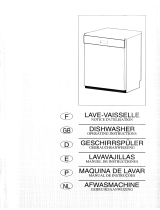
Mpore…te akÒmh na sumbouleuqe…te tij
eikÒnej aut™j sto scedi£gramma pou saj
parad…detai me th suskeu».
SÚndesh sto d…ktuo neroÚSÚndesh sto d…ktuo neroÚ
SÚndesh sto d…ktuo neroÚSÚndesh sto d…ktuo neroÚ
SÚndesh sto d…ktuo neroÚ
Gia na sund™sete to PLUNTHRIO PIATWN
sto D…ktuo NeroÚ, qa pr™pei na
crhsimopoi»sete to SWLHNA PIESHS pou
saj promhqeÚoume me th suskeu». Sund™ste
ton se mia brÚsh neroÚ pou diaq™tei stÒmio
me p£sa R 3/4" (Eik. 16).
H P…esh leitourg…aj pr™pei na
perilamb£netai metaxÚ 4,9 - 98 N/cm2. Se
per…ptwsh pou e…nai megalÚterh, qa pr™pei
na topoqet»sete mia balb…da me…wshj thj
p…eshj pou mpore…te na agor£sete sta
Katast»mata tou scetikoÚ kl£dou.
PolÚ shmantikÒPolÚ shmantikÒ
PolÚ shmantikÒPolÚ shmantikÒ
PolÚ shmantikÒ
O Swl»naj eisagwg»j tou neroÚ pr™pei na
topoqethqe… cwr…j gwn…ej » straggalismoÚj
pou na empod…zoun thn aprÒskopth eisagwg»
tou neroÚ sto PLUNTHRIO PIATWN.
Eisagwg» zestoÚ neroÚEisagwg» zestoÚ neroÚ
Eisagwg» zestoÚ neroÚEisagwg» zestoÚ neroÚ
Eisagwg» zestoÚ neroÚ
An kai e…nai protimÒtero na k£nete th
sÚndesh sth brÚsh krÚou neroÚ, merik£
mont™la mporoÚn na sundeqoÚn e…te sth
brÚsh krÚou e…te sth brÚsh zestoÚ neroÚ
(max. 60ºC). Sumbouleuqe…te to kat£sthma
apÒ Òpou agor£sate th suskeu».
SÚndesh exagwg»j neroÚSÚndesh exagwg»j neroÚ
SÚndesh exagwg»j neroÚSÚndesh exagwg»j neroÚ
SÚndesh exagwg»j neroÚ
H SUNDESH EXAGWGHS TOU NEROU g…netai
m™sw enÒj swl»na me gwn…a pou pr™pei na
plhre… tij akÒlouqej sunq»kej:
1.- To m»koj tou swl»na qa pr™pei na e…nai
mikrÒtero apÒ 3 m™tra.
2.- To £kro tou swl»na exagwg»j pr™pei na
param™nei se ™na Úyoj metaxÚ 0,5 kai 1
m™tro se sc™sh me to d£pedo (Eik. 17).
3.- E…nai apara…thto na topoqet»sete ™na
sifÒni ™tsi èste to sÚsthma na mhn
parousi£zei osm™j.
4.- Na pros™cete na mhn dhmiourgoÚntai
sto swl»na gwn…ej » straggalismo… pou
mporoÚn na empod…soun thn aprÒskopth
™xodo tou neroÚ.
PolÚ shmantikÒPolÚ shmantikÒ
PolÚ shmantikÒPolÚ shmantikÒ
PolÚ shmantikÒ
AfoÚ pragmatopoi»sete th sÚndesh,
bebaiwqe…te Òti h gwn…a tou swl»na e…nai
kal£ sterewm™nh sthn ™xodo, ™tsi èste na
apofeÚgontai tucÒn diarro™j neroÚ pou qa
mporoÚsan na plhmmur…soun to dwm£tio.
Hlektrik» sÚndeshHlektrik» sÚndesh
Hlektrik» sÚndeshHlektrik» sÚndesh
Hlektrik» sÚndesh
Ta PLUNTHRIA PIATWN maj mporoÚn na
d™contai reÚma me anètath ™ntash 16 A.
SUNDEOMENA APARAITHTA SE PRIZA ME
GEIWSH.
To KALWDIO TRODOFOSIAS thj suskeu»j
diaq™tei ™na £kro ge…wshj to opo…o qa pr™pei
na sund™etai opwsd»pote m™sw thj
kat£llhlhj pr…zaj pou na exasfal…zei th
sun™ceia sth ge…wsh.
Prin sund™sete to bÚsma thj suskeu»j sto
reÚma, e…nai apara…thto na bebaiwqe…te Òti h
t£sh reÚmatoj thj oik…aj saj sump…ptei me
thn t£sh leitourg…aj tou PLUNTHRIOU
PIATWN.
H t£sh leitourg…aj anagr£fetai sthn
PLAKA CARAKTHRISTIKWN pou
br…sketai sto plaïnÒ thj pÒrtaj thj
suskeu»j.
An to kalèdio trofodos…aj parousi£zeiAn to kalèdio trofodos…aj parousi£zei
An to kalèdio trofodos…aj parousi£zeiAn to kalèdio trofodos…aj parousi£zei
An to kalèdio trofodos…aj parousi£zei
bl£bh, qa pr™pei na antikaq…statai. Hbl£bh, qa pr™pei na antikaq…statai. H
bl£bh, qa pr™pei na antikaq…statai. Hbl£bh, qa pr™pei na antikaq…statai. H
bl£bh, qa pr™pei na antikaq…statai. H
allag» tou mpore… na pragmatopoie…taiallag» tou mpore… na pragmatopoie…tai
allag» tou mpore… na pragmatopoie…taiallag» tou mpore… na pragmatopoie…tai
allag» tou mpore… na pragmatopoie…tai
mÒnon apÒ ton kataskeuast», to TecnikÒmÒnon apÒ ton kataskeuast», to TecnikÒ
mÒnon apÒ ton kataskeuast», to TecnikÒmÒnon apÒ ton kataskeuast», to TecnikÒ
mÒnon apÒ ton kataskeuast», to TecnikÒ
tou S™rbij » apÒ exousiodothm™notou S™rbij » apÒ exousiodothm™no
tou S™rbij » apÒ exousiodothm™notou S™rbij » apÒ exousiodothm™no
tou S™rbij » apÒ exousiodothm™no
proswpikÒ.proswpikÒ.
proswpikÒ.proswpikÒ.
proswpikÒ.
O KATASKEUASTHS DEN APODECETAI
KAMMIA EUQUNH
SE PERIPTWSH POU DEN ECEI THRHQEI
KAPOIA APO TIS NORMES AUTES.
To parÒn plunt»rio pi£twn plhre… ta
problepÒmena sthn Eurwpaïk» Odhg…a 87/
308/CEE se sc™sh me tij radiohlektrik™j
diatarac™j hlektrikèn suskeuèn.
39
ELLHNIKAELLHNIKA
ELLHNIKAELLHNIKA
ELLHNIKA


















